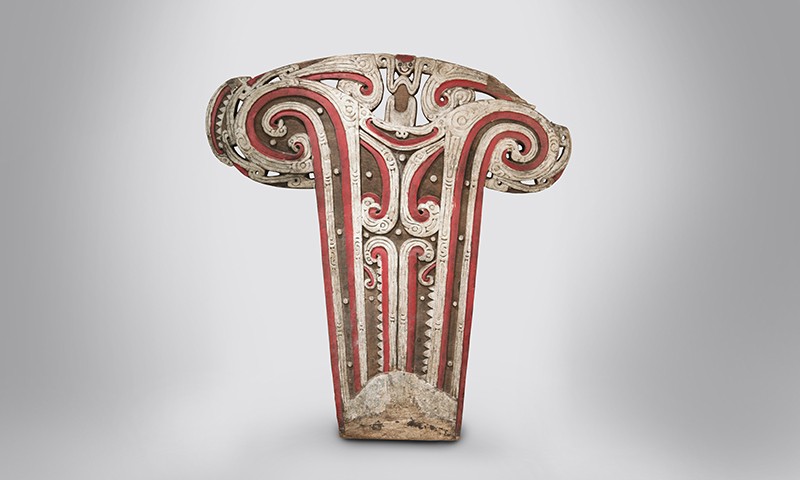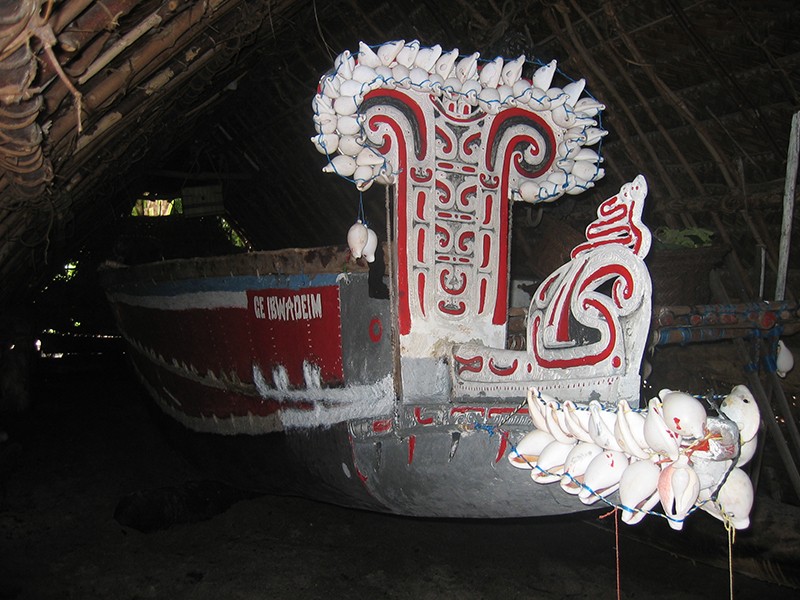 |
Splashboard (Lagim), 20th Century
Massim culture; Trobriand Islands, Milne Bay Province, Papua New Guinea, Melanesia, Oceania
Wood and paint; 32 5/8 x 25 5/8 x 2 5/8 in.
2011.11.2
Collected on behalf of the Bowers Museum by the Roski-Keller-Martin Expeditions 2000-2008 |
Art of the Deal
When it comes to making deals, everyone wants a leg up on the competition. In the western world, this might be done through advertising or price cutting, but in Papua New Guinea’s Milne Bay Province, the best trade advantage one can earn comes from a splashboard. In this post we take a close look at how the Massim culture of the Trobriand and Woodlark Islands make splashboards, the significance of their designs, their utilitarian function, and how all of this together plays into better return on investments when bartering in the region’s Kula trade, a multidirectional ring of trade that takes place in Papua New Guinea’s Milne Bay Province.
 |
| A man from Misima Island carrying a Woodlark Island-style splashboard. Taken during the Roski-Keller-Martin Expedition to Milne Bay in 2003. |
Freehand Ficus
Popular Massim belief holds that a woman so much as touching a Kula canoe corrupts it and causes it to sink on a following voyage. It is perhaps unsurprising that Massim ship carving is practiced exclusively by men. For boys interested in becoming carvers, learning this trade takes years and is a highly ritualized procedure including apprenticeships, various initiation ceremonies and a system of taboos. As much of the importance of splashboards lies in their magical ability to protect sailors from harm and ensure better transactional rates, it is of the utmost importance that carvers follow the rules laid out for them. When a carver has finally learned all the necessary techniques, the wood for a splashboard is cut from a single section of ficus root. Carvings must be done freehand, explaining why even works by masters tend to be visibly asymmetrical. Designs are only incised into what will become the exterior face of the splashboard. The final touch to the object is the addition of pigments to the carved side. Black, white, and red pigments were traditionally used, obtained from burnt coconut, chalk or coral, and a red berry called malaka. The blue seen on the splashboards of the mid and late 20th Centuries was traded for.
 |
Splashboard (Lagim), 20th Century
Massim culture; Woodlark Island, Milne Bay Province, Papua New Guinea, Melanesia, Oceania
Wood, paint and metal
2018.14.27
Anonymous Gift |
Volute Venturing
Massim splashboards earn their name in more ways than just protecting their canoe’s sailors from seawater: they universally share the rolling forms of waves. Otherwise, though, their designs vary widely depending on where they were made. The two production centers featured in this post are the Trobriand Islands and Muyua (Woodlark) Island, respectively located at the 11- and 2-o-clock positions of the Kula ring. Splashboards from the Trobriand Islands tend to have downward curving volutes framing a crown with one or two stylized figures in its center, as can be seen in two of this post’s examples. As if at an opposite end of the same scale, Woodlark Island splashboards tend to have volutes that curve upwards, giving the top of the splashboard an appearance that has been described as a lobe. In almost all splashboards from Woodlark, we see the morning star—the most important navigational landmark for the Massim—carved in openwork at three points in the crown.
 |
Splashboard (Lagim), 20th Century
Massim culture; Trobriand Islands, Milne Bay Province, Papua New Guinea, Melanesia, Oceania
Wood, paint and metal
2018.14.29
Anonymous Gift |
Prow Purpose
Despite being highly ornamented, the primary purpose of splashboards is functional. They are socketed into the hull of Massim canoes at both ends so that they are perpendicular to the length of the vessels, and have their decorated sides facing outwards. In addition to protecting sailors from splash, their shape structurally reinforces the sides of the vessels, allowing for a deeper hull. This is a necessity for Kula trade, which requires very large canoes to traverse the deep waters between the individual islands involved. Most splashboards are not made for the relatively few giant canoes, but instead for the smaller canoes islanders might use for fishing or other local needs. All the splashboards in this post are small enough that they would have been used for smaller vessels.
 |
| Large Kula canoe stored in a warehouse on the Marshall Bennett Islands. Taken during the Roski-Keller-Martin Expedition to Milne Bay in 2003. |
Kula Chameleon
The major goods traded in the Kula ring are shell necklaces and bracelets, but even though splashboards are not exchanged they still play a paramount role as weapons of magical and psychological warfare. The Massim’s belief is that the magic imbued during the carving along with the designs, colors, and the beautiful shell adornments—the cause for the perforations around the tops of the splashboards—affects a sort of mind control on one’s trading partner so that they only bring out their finest wares to exchange and demand less in return. And there is no reason to believe that this is not the case. Red is the color we see most predominantly in these splashboards and it is the second most-used color by top brands for its ability to elicit passionate, uncalculated responses. Faced with a sea of splashboards spearheading an imposing trading flotilla, offering better deals might seem like the only option available.
Text and images may be under copyright. Please contact Collection Department for permission to use. References are available on request. Information subject to change upon further research.






Comments